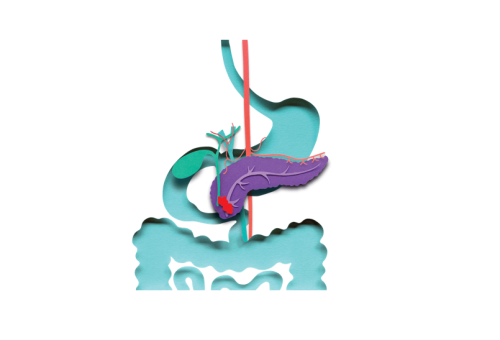Pancreatic Cancer Types and Stages
Identifying pancreatic cancer subtypes and stages
After a biopsy or surgery confirms pancreatic cancer, a pathologist will look at the cell type and may perform tests. Additional tests will be ordered to look for cancer spread through the local tissue or to distant organs. Together, these tests provide clues on how to best treat the cancer.
Types of pancreatic cancer
The pancreas helps your body break down food, and especially the fat in your diet and turn it into energy. It is also critical for controlling sugar levels and preventing diabetes. The pancreas has two main types of cells:
- Exocrine cells make and release chemicals known as enzymes into your small intestine to help your body digest food.
- Endocrine cells make hormones, including insulin, which controls the amount of sugar in your bloodstream. These cells are also called Islet cells.
Pancreatic exocrine cancers
These are the most common type of pancreatic cancer. They are also the type most associated with inherited mutations.
- Most pancreatic exocrine cancers start in the ducts. They are called ductal adenocarcinomas.
- Other, more rare exocrine cell cancers include: acinar cell carcinoma, adenosquamous carcinoma, colloid carcinoma, giant cell tumor, hepatoid carcinoma, mucinous cystic neoplasms, pancreatoblastoma, serous cystadenoma, signet ring cell carcinoma, solid and pseudopapillary tumors, squamous cell carcinoma, and undifferentiated carcinoma.
Stages of pancreatic exocrine cancer
The refers to whether the cancer has spread, and if so, where in the body the cancer has spread. Identifying the of pancreatic cancer helps doctors decide how to treat it. In pancreatic cancer, is done using imaging tests before surgery, to group the cancer into one of the following stages:
- Resectable tumors appear on imaging to be completely removable with surgery. About 20% of pancreatic exocrine cancers fall into this category.
- Unresectable tumors may be locally advanced tumors. These cannot be removed by surgery because they have invaded the nearby blood vessels. Locally advanced tumors have not spread to other organs.
- tumors are those that have spread to other organs outside of the pancreas. tumors are also considered unresectable.
- With borderline resectable tumors, the doctor cannot tell from imaging if the tumor has spread to the blood supply or other organs, or if the tumor appears to touch important structures in a limited fashion.
Intraductal papillary mucinous neoplasms (IPMN)
Intraductal papillary mucinous neoplasm (IPMN) is an abnormal growth within the ducts of the pancreas. If left without treatment, some may become cancerous. As more people are being screened for pancreatic cancers, more IPMNs are being found.
IPMNs are distinguished by the part of the pancreas where they arise.
- Main duct type IPMNs arise from the main duct of the pancreas. These IPMNs tend to be more aggressive and are more likely to turn into cancer than branch duct IPMNs. Main duct IPMNs are often surgically removed.
- Branch duct IPMNs start in the branches of the pancreatic duct. Many of these IPMNs never turn into cancer. Branch duct IPMNs become more concerning if they have any of the following features:
- are growing over time
- are larger than 3 cm
- are causing dilation in the main duct of the pancreas
- contain a solid mass
- are causing symptoms
Let's Win! Pancreatic Cancer

Let's Win! Pancreatic Cancer has detailed information on the different stages of pancreatic cancer.
Pancreatic endocrine cancers
Endocrine cell cancers are more rare than exocrine cell cancers. They form in the cells that make hormones that are necessary to control blood sugar and other metabolic functions. They may also be called islet cell tumors, or pancreatic neuroendocrine tumors (PNETs). Endocrine cell cancers are treated based on their , grade and tumor type. Inherited mutations in CDKN1B, MEN1, , TET and VHL are linked to increased risk for PNETs.
Pancreatic neuroendocrine tumor
Measuring the of the cancer can help doctors decide on the best way to treat it.
|
|
Description |
|
1 |
The cancer is less than 2 cm and has not spread beyond the pancreas. |
|
2 |
The cancer is less than 4 cm and has not spread beyond the pancreas, the bile duct or the duodenum. The cancer has not spread to the or distant areas of the body. |
|
3 |
The cancer may have spread to nearby organs, or blood vessels, but has not spread to distant areas of the body. |
|
4 |
The cancer has spread to the liver or other distant areas of the body. |
Other factors that affect treatment and outlook
Other features of PNETs play a role in how they are treated. These include:
- the grade, which measures how quickly the cancer cells are growing.
- whether or not the tumor is producing hormones.
- whether or not the tumor expresses somatostatin receptors.
- whether or not all, or the bulk of the tumor can be removed surgically.